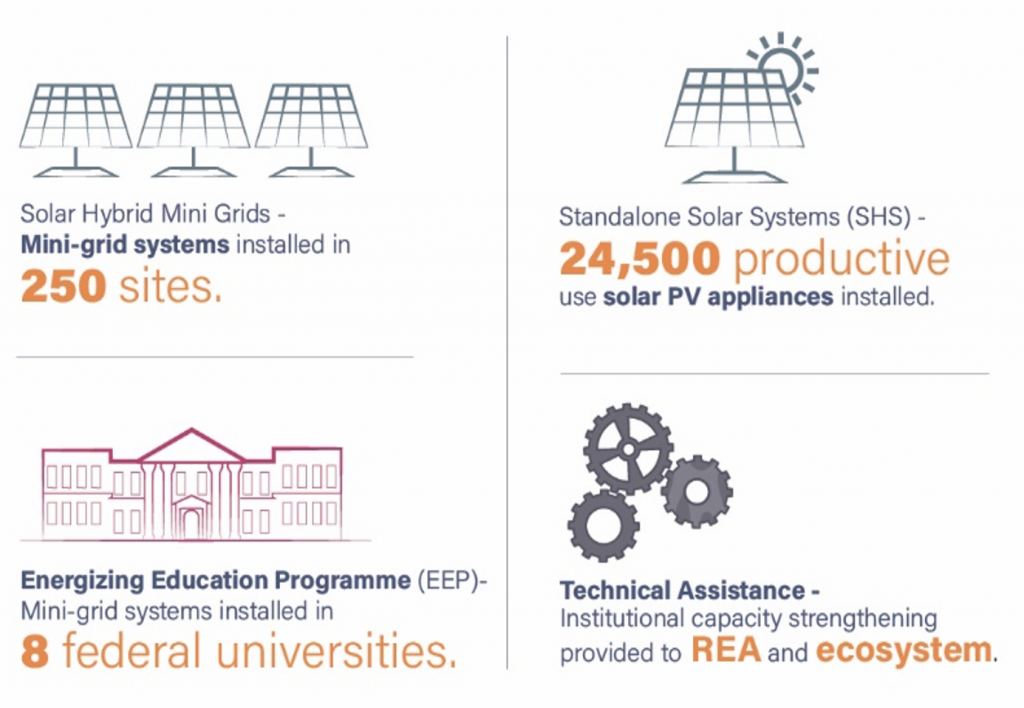The Nigerian Electrification Project (NEP) is a federal government scheme designed in 2018 with the World Bank, the African Development Bank (AfDB), and other partners to provide energy access to under- and unserved communities in Nigeria using renewable sources. It is a private sector-driven nationwide initiative implemented by the country’s Rural Electrification Agency (REA). The Project promotes electricity access for households, micro, small, and medium enterprises (MSMEs), and public education institutions. It specifically aims to provide cost-effective power to 250,000 MSMEs and 1 million households through off-grid and mini-grid systems by 2023 via four main components:1
- Solar Hybrid Mini-grids – Mini-grid systems installed in 250 sites.
- Standalone Solar Systems (SHS) – 24,500 productive use solar PV appliances installed.
- Energizing Education Programme (EEP) – Mini-grids installed in 8 federal universities.
- Technical Assistance – Institutional capacity strengthening provided to REA and private organizations in the ecosystem by international partners.2
What does the NEP plan look like?
Aim: Catalyze electricity infrastructure development in Nigeria by accelerating the mini- and off-grid sectors in rural areas where energy access is a challenge.
Approach: Facilitate entry for new market participants, especially the private sector, through the Solar Hybrid Mini-grids component that includes 1) a minimum-subsidy tender aimed at electrifying selected communities with high economic growth potential, and 2) a performance-based grant program for mini-grids based on developers’ preferences.3
Financing: The REA has secured $350 million from the World Bank and $200 million from the AfDB) which are expected to crowd in an additional $660 million from the private sector.
Technical assistance: Due to limited domestic experience implementing these systems, supporting donor institutions work with the REA and potential developers to provide strategic guidance and training for geospatial assessments, feasibility studies, market scoping reports, and other related studies in order to mitigate risks and improve performance.
What to watch for
The COVID-19 pandemic largely hampered the initial launch of some components of the NEP. However, the REA resumed implementation activities at the beginning of 2021 and is determined to deliver as promised. As at June 2021, a total of 225,809 households and MSMEs now have power through the Project using mini-grids (530kW) and SHS (8100kW).4
However, some critical issues surrounding long-term sustainability warrant careful consideration as the NEP progresses:
Subsidies: The NEP subsidizes large-scale development of mini-grids by shrinking initial costs and creating room for scaling operations and recovery of investments by developers during the project cycle. The project may become unaffordable and unsustainable long-term, when the subsidies are phased out or distort the market if subsidies are not properly managed.
Domestic financing: Due to the limited record of mini-grid development in the country, domestic financing institutions tend to view such projects as high-risk assets, which may constrain the ability of projects to raise capital.
Outlook and scalability
So far, many analysts see the NEP as a high-impact project that will not only contribute to delivering electricity access, but will also drive the productive use of electricity for industrial processes, especially in the agriculture sector. It is also envisaged that the project will substantially improve institutional frameworks through technical and human capacity building in Nigeria’s power sector. It is hoped that the hosting institution, the REA, will become the most advanced rural electrification agency in sub-Saharan Africa with respect to the use of decentralized renewable energy systems.5 Overall, the Project’s innovative market strategy and mechanisms could prove a strong model for other sub-Saharan African countries looking to accelerate and advance electricity access using decentralized renewable energy systems.
Endnotes
- Nigerian Electrification Programme, Rural Electrification Agency.
- Nigeria Electrification Project, African Development Bank.
- Nigerian Electrification Programme, Rural Electrification Agency.
- Achievements, Rural Electrification Agency.
- “The Nigeria Electrification Project (NEP) – Scaling Up Mini-Grid development,” African Development Bank. February 2019.

